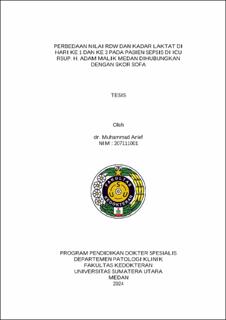| dc.description.abstract | Background: Sepsis remains the leading cause of death in critically ill patients. Thus, regular measurement of lactate levels has been proposed in the sepsis guidelines. Elevated (RDW) and lactate were associated with the risk of death in patients with sepsis.
Objective: This study aims to investigate difference between RDW and lactate on days 1 and 3 in septic patients admitted to the ICU and associated with SOFA scores.
Methods: This study took blood samples of 30 patients treated in the ICU. Samples were examined for RDW and lactate on days 1 and 3, while calculating SOFA scores on days 1 and 3. The study was conducted after obtaining ethical approval and informed consent.
Results and Discussion: 18 men (60%) and 12 women (40%) with the youngest 18 years old and the oldest 65 years old. By using the Spearman correlation test, no significant correlation was found between RDW and SOFA (p = 0.674). Likewise for lactate, it also did not have a significant relationship with SOFA scores on the first day of care for patients with sepsis (p = 0.320). By using the Spearman correlation test, no significant correlation was found between RDW and SOFA (p = 0.095). However, for lactate, it was shown that there was a significant correlation with SOFA scores on the third day of treatment for patients with sepsis (p = 0.023).
Conclusions and suggestions: RDW and SOFA scores on days 1 and 3 had no significant relationship with patients with sepsis, however, for lactate, they showed a significant relationship/correlation with SOFA scores on the third day of treatment with patients with. Further research needs to be done with larger study subjects to see the relationship between RDW, lactate and SOFA scores in septic patients, and can be used as a prognostic of mortality in sepsis patients. | en_US |


